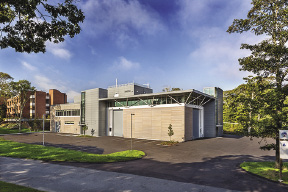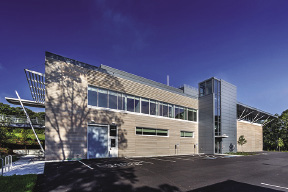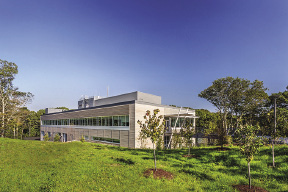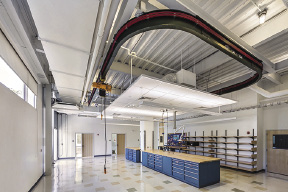Exploring the depths of the unknown is the Woods Hole Oceanographic Institution's specialty. As a global leader in ocean research, Woods Hole Oceanographic Institution (WHOI) is dedicated to understanding all features of the ocean. Since its founding in 1930, WHOI has worked collaboratively to advance awareness of the ocean and the importance of its resources. With the recent addition of a new state-of-the-art research building, the Laboratory for Ocean Sensors and Observing Systems (LOSOS), WHOI continues its mission of providing scientists and engineers from around the world with valuable data from the ocean.
Located on WHOI's Quissett Campus, the 27,000 s/f, 2-story structure includes laboratory and office space for a number of user groups including the Ocean Observatories Initiative, the Martha's Vineyard Coastal Observatory, the WHOI Ocean Bottom Seismometer Instrument Pool, and the Environmental Sample Processor Lab.
Built by Columbia Construction Co., and designed by Ellenzweig, the facility is highly sustainable and technology advanced. It was designed and constructed to promote collaboration and interaction, allowing for flexible research.
As WHOI's technical and functional needs span such a wide spectrum of space types, each area of the building is tailored to specific user requirements. The design incorporates casework and building systems that are easily reconfigured. Other areas include wet bench research space, special cleanroom environments, high-bay buoy service areas, carefully climate-controlled rooms for equipment calibration, and a wide range of instrument service areas.
As there were no "prototypes" to aid in the programming and design of these spaces, the team relied on discussions with building users. With the active help of WHOI scientists and engineers, many potential solutions were tested until the final design evolved to what LOSOS is today - a building that will be the home for the next generation of oceanography.
"A hallmark of WHOI is the strong positive reinforcement of science and technology. The LOSOS facilities are completely customized to meet the demands of sustained, multi-disciplinary ocean observing," said Ernest Charette, CPE, director of Construction Projects at Woods Hole Oceanographic Institution. "Providing immediate efficiencies for ongoing operations and development, the facility greatly enhances each team's opportunities for shared benefits from working in close proximity to other ocean observing programs."
LOSOS is WHOI's first LEED certified laboratory, earning a LEED Gold rating. It incorporates many energy efficient systems including radiant-heat flooring in the high-bay area, high-efficiency combustion boilers, as well as high-reflectance roofing materials all of which will deliver up to 15% in energy savings. Additionally, the Atlantic White Cedar Siding installed on the building's exterior was recovered from areas of North Carolina after the devastation of Hurricane Katrina.
In September, WHOI held a dedication ceremony for the new $10 million facility. WHOI president and director Susan Avery was present along with the National Institute of Standards and Technology (NIST) associate director for laboratory programs and principal deputy Willie May.
WHOI received an $8.1 million grant from NIST in 2010 to fund construction of the new scientific research facility.












.png)